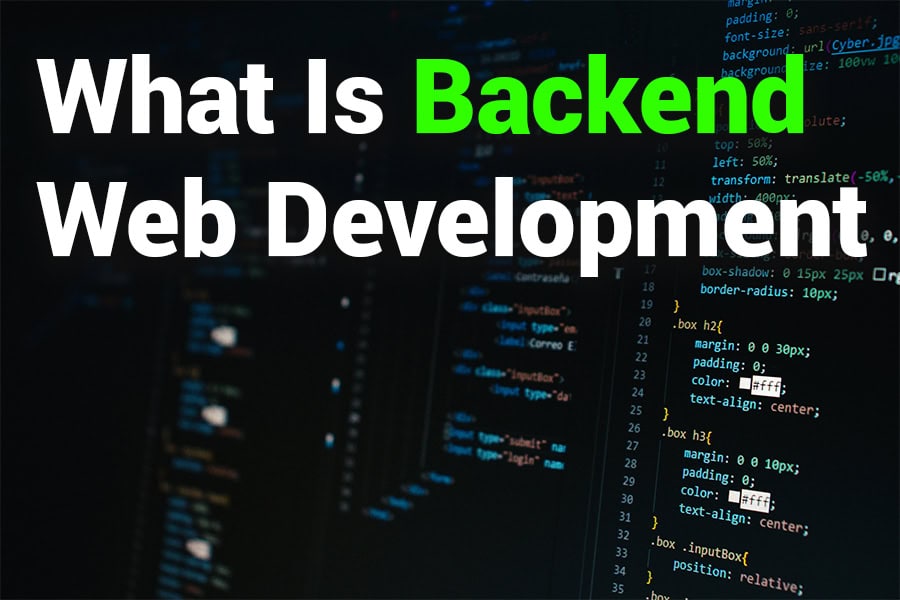What is Backend Web Development? Essential Guide for Aspiring Developers

Backend web development is the engine that powers websites and web applications, providing functionality beyond what users see on their screens. The backend of a website makes it interactive, secure, and dynamic. Whenever a user fills out a form, uploads a photo, or checks their account, the backend processes the information and communicates with the server to retrieve data or perform tasks. The backend manages this data, handles requests, and ensures the system performs reliably, securely, and at scale.
The demand for backend developers has skyrocketed as more businesses go digital and require sophisticated web applications to support their operations. These developers use programming languages like Python, PHP, and Ruby and rely on frameworks and databases to create and maintain the critical systems that drive web applications. This article will explore backend development, its essential tools, key concepts, and how it integrates with frontend development to provide a seamless user experience.
What is Backend Web Development?
Backend web development is server-side development that powers the operations of websites and web applications. It involves creating and managing the components responsible for data storage, processing, and security. While the front end handles the visual aspects users interact with, the back end ensures data processing, storage, and retrieval. Backend developers work with languages like Python, PHP, and Node.js and use frameworks and databases to build robust, efficient, and scalable web applications that run seamlessly behind the scenes.
The Basics of Backend Web Development?
Backend web development deals with the server side of web applications, managing how they operate behind the scenes. It’s responsible for handling all server, database, and API interactions to deliver a smooth user experience. Here’s a closer look at the components and importance of backend web development:
- Data Storage and Retrieval: A significant part of backend development involves managing data. Whether it’s user accounts, product information, or multimedia files, backend developers structure and store data so that it can be efficiently retrieved and updated. This often involves working with SQL (MySQL, PostgreSQL) or NoSQL databases (MongoDB, Cassandra).
- Server Logic and Processing: Backend developers write server-side code that responds to user actions. For instance, when a user submits a login form, the backend authenticates the user by matching the input with stored data. This involves scripting in Python, PHP, Ruby, or JavaScript (Node.js) to implement application logic, process inputs, and return data to the user.
- APIs and Data Communication: APIs (Application Programming Interfaces) enable the backend to interact with external and front-end services. RESTful APIs and GraphQL are popular methods for structuring and managing these interactions. APIs are crucial as they allow data exchange between systems, enabling features like social media integration, third-party payments, or cloud storage access.
- Security and User Authentication: Security is paramount in backend development, as it manages sensitive information. Developers must secure data at every stage by implementing authentication mechanisms, encrypting data, and employing secure coding practices. This involves using tools and techniques like HTTPS, token-based authentication (JWT), and role-based access control (RBAC).
- Optimization and Scalability: As applications grow in popularity, they must handle increased traffic without crashing. Backend developers optimize code and server infrastructure to support a growing user base. Scaling techniques include database indexing, caching, and load balancing.
Why is Backend Development Important in Web Applications?
Enhancing User Experience
Backend development significantly impacts the user experience by ensuring applications respond quickly and function as intended. Imagine using an app where the data doesn’t load or takes too long to display. Backend developers work to minimize these delays, creating responsive applications that make user interactions smooth and satisfying.
Data Security and Privacy
Backend development plays a critical role in safeguarding sensitive data in today’s world, where data breaches are common. Backend developers protect information by implementing encryption, user authentication, and access controls, preventing unauthorized access and cyber threats. This security is essential for user trust, especially for applications handling personal or financial information.
Scalability and Efficiency
As user traffic grows, applications must scale to meet demand. Backend developers ensure applications can handle high traffic without crashing by optimizing database queries, managing server load, and implementing caching strategies. This allows businesses to grow without sacrificing performance, providing a seamless experience for all users, regardless of demand spikes.
Integration with External Services
Modern web applications rely on integrations with other services, such as payment gateways, cloud storage, and social media platforms. Backend developers enable these integrations, enhancing applications’ functionality and convenience. APIs facilitate data exchange between systems, allowing applications to leverage external services without compromising performance or security.
Managing Data Complexity
Backend systems are designed to handle large volumes of complex data. By structuring data in organized databases and implementing search functions, backend developers make accessing, analyzing, and manipulating data easy. This capability is invaluable for businesses that rely on data-driven decisions to personalize user experiences, optimize operations, and improve services.
Technologies in Backend Web Development
Backend development utilizes various technologies to build robust applications. Here are the main ones:
- Programming Languages: Backend developers use Python, JavaScript (Node.js), Ruby, and PHP. Each language has unique strengths suited to different applications. Python is popular for data processing, Node.js for real-time applications, Ruby for simplicity, and PHP for compatibility with various content management systems.
- Frameworks: Frameworks like Django, Express.js, Ruby on Rails, and Laravel simplify backend development. They provide predefined functions and structures, allowing developers to create robust applications quickly. Frameworks are particularly helpful for handling repetitive tasks like database management, routing, and API development.
- Databases: Databases are crucial for data storage and retrieval. SQL databases (e.g., MySQL, PostgreSQL) are excellent for structured data, while NoSQL databases (e.g., MongoDB, Redis) offer flexibility for handling unstructured data. Backend developers choose databases based on the application’s needs and anticipated data complexity.
- APIs: APIs facilitate communication between different parts of a system and third-party services. RESTful APIs and GraphQL are widely used in backend development. RESTful APIs allow for standard HTTP methods like GET, POST, PUT, and DELETE, while GraphQL enables flexible data retrieval, which can be more efficient.
- Servers: Servers like Apache and Nginx host backend applications, handling user requests and delivering responses. Understanding server management and deployment is essential for backend developers, especially when configuring load balancing, caching, and security.
How do you get started in back-end web development?
Backend development requires learning specific tools, languages, and concepts. Here’s a roadmap to get you started:
- Learn a Backend Language: Start with languages commonly used in backend development, such as Python, JavaScript (Node.js), PHP, or Ruby. Each language has a supportive ecosystem and plenty of learning resources, making them accessible to beginners.
- Master Databases: Databases are central to backend development, so it’s essential to understand both SQL and NoSQL options. SQL databases like MySQL and PostgreSQL are ideal for structured data, while NoSQL databases like MongoDB are suited for flexible data models.
- Explore Frameworks: Frameworks streamline backend development by providing a predefined structure. Django (Python), Express (Node.js), and Laravel (PHP) are popular choices. Learning a framework allows you to build web applications more efficiently, as you can focus on core functionality without reinventing the wheel.
- Understand API Development: APIs are integral to backend development, facilitating communication between services. Familiarize yourself with REST and GraphQL, as they are widely used for creating flexible and efficient data exchanges.
- Gain Server Knowledge: Backend developers need to understand how servers work, including deployment, server management, and scaling. Platforms like Heroku, AWS, and DigitalOcean offer cloud services that simplify deployment, while Apache and Nginx are popular choices for configuring servers.
How Does Backend Web Development Differ from Frontend Development?
Visible vs. Invisible Layers: Frontend development focuses on the elements users interact with, such as layout, design, and functionality. Backend development, however, is responsible for processing and delivering data to the front end, making it the invisible part of the application.
Languages and Tools: Frontend developers use HTML, CSS, and JavaScript to create a responsive and visually appealing user interface. In contrast, backend developers rely on server-side languages like Python, Ruby, and PHP to build the logic behind user interactions.
Interaction with Data: Backend developers use databases to store, retrieve, and update data. In contrast, front-end developers use this data to create an engaging user experience. For example, a backend developer ensures that a user’s profile information is stored securely in a database, while a frontend developer displays this data on the user’s profile page in a visually appealing way.
User Experience Frontend development focuses heavily on the user experience (UX), aiming to create a smooth, attractive, and interactive interface. However, backend development ensures that this interface has the necessary data and functionality so users receive accurate, fast, and reliable responses when interacting with the application.
Security and Scalability Backend developers are vital in maintaining data security and scalability. They implement security measures to protect sensitive information, such as user credentials and personal data, and build the infrastructure to scale as the application grows. Conversely, front-end developers implement best practices to ensure secure interactions but are less involved in data security.
Bottom Line
Backend web development is the backbone of any web application, ensuring that data is processed, stored, and delivered securely and efficiently. It enables seamless interactions, manages data privacy, and supports the scalability that growing applications need. As businesses increasingly rely on complex web applications, the role of backend developers becomes more critical, ensuring that web systems are robust, responsive, and secure.
Whether you’re a beginner interested in learning backend development or a business leader curious about what goes on behind the scenes, understanding backend web development provides insight into how today’s digital world operates. With the right skills and knowledge, backend developers create the invisible systems that drive our online experiences, making them faster, safer, and more reliable.
FAQ’s
Q. What is the main focus of backend web development?
A. Backend web development focuses on server-side functionality, managing data storage, application logic, and APIs to ensure that web applications function smoothly and securely.
Q. Which programming languages are most popular for backend development?
A. Some popular backend programming languages include Python, PHP, JavaScript (Node.js), Ruby, and Java. Each language has its strengths and use cases.
Q. How does backend web development differ from frontend development?
A. Backend development manages the server side, handling data processing, storage, and security, while frontend development focuses on the visual and interactive parts that users interact with.
Q. What are the essential skills for a backend developer?
A. Essential skills include proficiency in backend programming languages, knowledge of databases, understanding of API development, familiarity with server management, and a focus on security practices.
